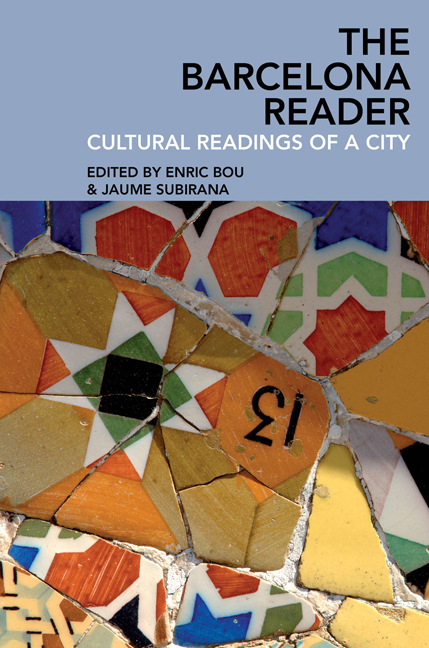Book contents
- Frontmatter
- Contents
- List of illustrations
- Notes on contributors
- Introduction: Barcelona: Cultural readings of a city
- I City, history, and territory
- II City and society
- 6 Barcelona and modernity
- 7 Football and identities in Catalonia
- 8 The family and the city: Power and the creation of cultural imagery
- 9 Memory and the city in Barcelona's cemeteries
- III Art, architecture, and the city
- IV The Olympics and the city
- V Literature, cinema, and the city
9 - Memory and the city in Barcelona's cemeteries
from II - City and society
- Frontmatter
- Contents
- List of illustrations
- Notes on contributors
- Introduction: Barcelona: Cultural readings of a city
- I City, history, and territory
- II City and society
- 6 Barcelona and modernity
- 7 Football and identities in Catalonia
- 8 The family and the city: Power and the creation of cultural imagery
- 9 Memory and the city in Barcelona's cemeteries
- III Art, architecture, and the city
- IV The Olympics and the city
- V Literature, cinema, and the city
Summary
Cemeteries constitute the most important urban site of memory and commemoration in modern society. In the nineteenth century the emotional focus of death moved from the dying to the survivors. Death was constructed as the death of the other, that is, around a new intolerance of separation and, consequently, around the suffering and distress felt by survivors (Ariès: 65–66). This new relationship between the living and the dead is based also on the peculiar fear of death felt in modern societies. As William Hazlitt explained in 1930, the modern fear of death is the fear ‘of no longer mattering in the world of affairs and, projecting back, of never having mattered at all’ (qtd. in Laqueur: 29). What is disturbing for the modern individual, what makes the thought or sight of death so unbearable, is ‘death as being forgotten’: ‘Memory is its antidote, and the cemetery made possible an undreamed of elaboration of personal commemoration and contemplation’ (Laqueur: 29–30). Modern – now historical – cemeteries came about, thus, as a remedy to the particular modern fear of death: oblivion. Fear of being forgotten and mourning are thus the basis for the extensive culture of death that characterized the nineteenth century. New cemeteries, funeral processions and memento mori objects were important sites for both private and public memory and commemoration and, as such, privileged sites for the construction of individual and collective identities. It is no surprising that they figure prominently in nineteenth-century culture and its literary and artistic imaginations.
The dominant nineteenth-century medical discourse on burial grounds considered cemeteries sites of the viral destructiveness of life. The constitution of cemeteries as counter-image of this hygienic discourse – that is, into a fundamental site for the construction of both individual and collective identities through commemoration – reconciled the inhabitants of the city with the new extramuros burial sites. The cemetery as lieu de mémoire gave the hygienic discourse on cemeteries the social and emotional meaning it lacked and made the new urban spaces of death readable.
- Type
- Chapter
- Information
- The Barcelona ReaderCultural Readings of a City, pp. 209 - 240Publisher: Liverpool University PressPrint publication year: 2017



